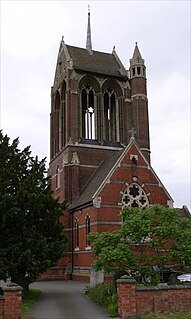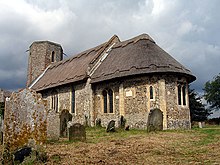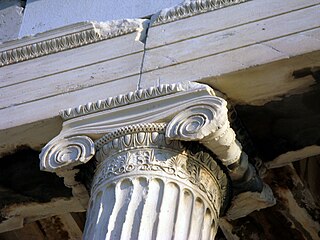
St Mary's Church is in Knowsley Lane, Knowsley Village, Merseyside, England. The church is recorded in the National Heritage List for England as a designated Grade II* listed building. It is an active Anglican parish church in the diocese of Liverpool, the archdeaconry of Liverpool and the deanery of Huyton. In the Buildings of England series, Pollard and Pevsner describe the church as being "largish" with "an intimate interior".

St John the Baptist's Church is a redundant Anglican church in the village of Stanwick St John, North Yorkshire, England. It is recorded in the National Heritage List for England as a designated Grade I listed building, and is under the care of the Churches Conservation Trust. The site of the church is recognised as a Scheduled Monument, and it stands within the earthworks of Stanwick Camp, a settlement originating in the early Iron Age.
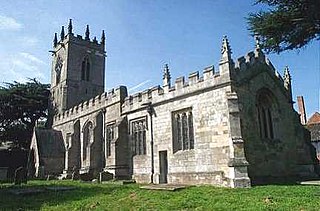
St Martin of Tours' Church is a redundant Anglican church in the village of Saundby, Nottinghamshire, England. It is recorded in the National Heritage List for England as a designated Grade I listed building, and is under the care of the Churches Conservation Trust.
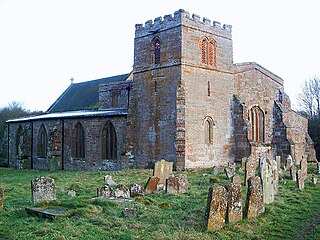
St Peter's Church is a redundant Anglican church standing in an isolated position in the civil parish of Wolfhampcote, Warwickshire, England. Since 1960 the church and its attached mausoleum have been recorded in the National Heritage List for England as a designated Grade II* listed building, and are now under the care of the Churches Conservation Trust. The church stands in a field which contains a number of mounds. These are partly the remains of the medieval village initially served by the church, which has been deserted village for centuries, partly from disused canal workings, and partly from the remains of a redundant railway line.

St Nicholas' Church is a redundant Anglican church in Normanton-on-Cliffe, Lincolnshire, England. It is recorded in the National Heritage List for England as a designated Grade II* listed building, and is under the care of the Churches Conservation Trust. It stands beside the road between Grantham and Lincoln.

All Saints' Church is a redundant Anglican church in the village of Icklingham, Suffolk, England. It is recorded in the National Heritage List for England as a designated Grade I listed building, and is under the care of the Churches Conservation Trust. The church stands in the highest point in the village, adjacent to the A1101 road between Mildenhall and Bury St Edmunds. This was formerly the ancient trackway of Icknield Way, and Icklingham is close to an important junction on this trackway.

St Mary's Church is a redundant Anglican round-tower church near the village of Moulton St Mary, Norfolk, England. It is recorded in the National Heritage List for England as a designated Grade I listed building, and is under the care of the Churches Conservation Trust. It stands some 4 kilometres (2 mi) to the south of Acle in an isolated position adjacent to a farm.

St Benedict's Church is a redundant Anglican church in the village of Haltham-on-Bain, Lincolnshire, England. It is recorded in the National Heritage List for England as a designated Grade I listed building, and is under the care of the Churches Conservation Trust. It stands between the River Bain and the A153 road connecting Horncastle with Coningsby.

All Saints Church, Saltfleetby, is a redundant Anglican church in the village of Saltfleetby All Saints, Lincolnshire, England. It is recorded in the National Heritage List for England as a designated Grade I listed building, and is under the care of the Churches Conservation Trust. The church stands in the marshland of Lincolnshire, and has a leaning west tower.

St Andrew's Church is a redundant Anglican church in the village of Willingale, Essex, England. It is recorded in the National Heritage List for England as a designated Grade II* listed building, and is under the care of the Churches Conservation Trust. The church stands less than 50 yards (46 m) from the adjacent church of St Christopher, and shares its churchyard.
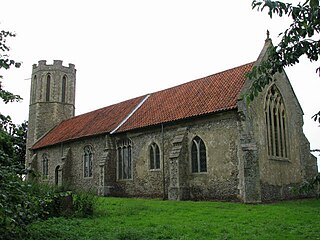
St Nicholas' Church is a redundant Anglican church in the village of Buckenham, Norfolk, England. It is recorded in the National Heritage List for England as a designated Grade I listed building, and is under the care of the Churches Conservation Trust. The church stands among fields to the north of the River Yare.

St Michael's Church is a redundant Anglican church in the hamlet of Coston, in the civil parish of Runhall, Norfolk, England. It is recorded in the National Heritage List for England as a designated Grade II* listed building, and is under the care of the Churches Conservation Trust. The church stands in an isolated position.

St Mary the Virgin's Church is a redundant Anglican church in the civil parish of Wiggenhall St Germans, Norfolk, England. It is recorded in the National Heritage List for England as a designated Grade I listed building, and is under the care of the Churches Conservation Trust. The church stands at the end of a lane to the north of the village of Wiggenhall St Mary the Virgin, some 5 miles (8 km) south of King's Lynn. It is notable particularly for the quality of carving of its wooden fittings.
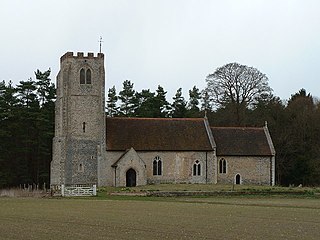
All Saints Church, West Harling, is a redundant Anglican church in the civil parish of Harling, Norfolk, England. It is recorded in the National Heritage List for England as a designated Grade I listed building, and is under the care of the Churches Conservation Trust. The church stands in an isolated position on the edge of Thetford Forest.
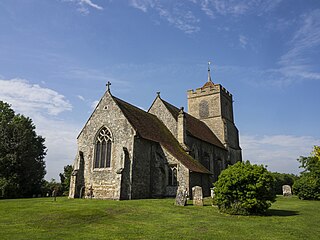
St Andrew's Church is a redundant Anglican church in the village of Buckland, Hertfordshire, England. It is recorded in the National Heritage List for England as a designated Grade II* listed building, and is under the care of the Churches Conservation Trust. The church stands at the highest point in the village to the east of Ermine Street, now the A10 road, between Royston and Buntingford.

St Mary's Church, East Bradenham, is a redundant Anglican church in the village of Bradenham, Norfolk, England. It is recorded in the National Heritage List for England as a designated Grade I listed building, and is under the care of the Churches Conservation Trust. The church stands at the east end of the village.

St Mary's Church is a redundant Anglican church in the village of East Ruston, Norfolk, England. It is recorded in the National Heritage List for England as a designated Grade II* listed building, and is under the care of the Churches Conservation Trust. The church stands in an isolated position on the east side of the B1159 road, some 2 miles (3 km) north of Stalham. It is noted for its 15th-century painted and carved chancel screen.

All Saints' Church is a redundant Anglican church in the village of Thurgarton, Norfolk, England. It is recorded in the National Heritage List for England as a designated Grade I listed building, and is under the care of the Churches Conservation Trust. The church stands in an isolated position on a crossroads north of the village, 6 miles (10 km) south of Cromer, to the west of the A140 road.

St Michael's Church is in Giantswood Lane, Hulme Walfield, Cheshire, England. It is an active Anglican parish church in the deanery of Congleton, the archdeaconry of Macclesfield, and the diocese of Chester. The church is recorded in the National Heritage List for England as a designated Grade II listed building. The authors of the Buildings of England series comment that it is "an attractive building, and one for which money must have been spent generously".
